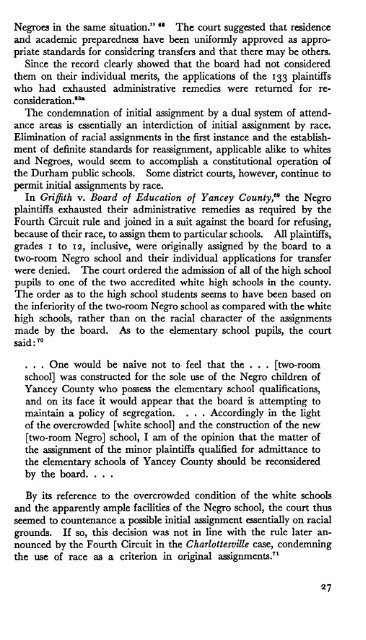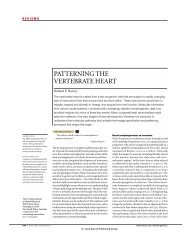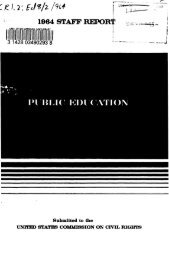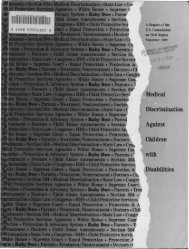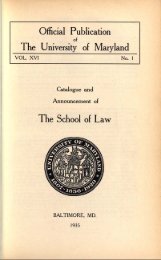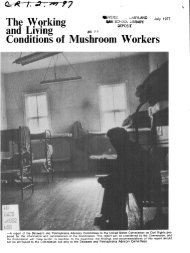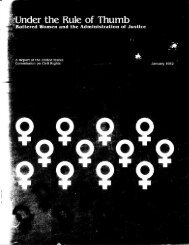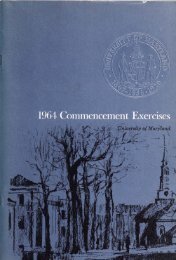1961 US Commission on Civil Rights Report Book 2 - University of ...
1961 US Commission on Civil Rights Report Book 2 - University of ...
1961 US Commission on Civil Rights Report Book 2 - University of ...
Create successful ePaper yourself
Turn your PDF publications into a flip-book with our unique Google optimized e-Paper software.
Negroes in the same situati<strong>on</strong>." " The court suggested that residence<br />
and academic preparedness have been uniformly approved as appropriate<br />
standards for c<strong>on</strong>sidering transfers and that there may be others.<br />
Since the record clearly showed that the board had not c<strong>on</strong>sidered<br />
them <strong>on</strong> their individual merits, the applicati<strong>on</strong>s <strong>of</strong> the 133 plaintiffs<br />
who had exhausted administrative remedies were returned for rec<strong>on</strong>siderati<strong>on</strong>.*<br />
8 *<br />
The c<strong>on</strong>demnati<strong>on</strong> <strong>of</strong> initial assignment by a dual system <strong>of</strong> attendance<br />
areas is essentially an interdicti<strong>on</strong> <strong>of</strong> initial assignment by race.<br />
Eliminati<strong>on</strong> <strong>of</strong> racial assignments in the first instance and the establishment<br />
<strong>of</strong> definite standards for reassignment, applicable alike to whites<br />
and Negroes, would seem to accomplish a c<strong>on</strong>stituti<strong>on</strong>al operati<strong>on</strong> <strong>of</strong><br />
the Durham public schools. Some district courts, however, c<strong>on</strong>tinue to<br />
permit initial assignments by race.<br />
In Griffith v. Board <strong>of</strong> Educati<strong>on</strong> <strong>of</strong> Yancey County* 9 the Negro<br />
plaintiffs exhausted their administrative remedies as required by the<br />
Fourth Circuit rule and joined in a suit against the board for refusing,<br />
because <strong>of</strong> their race, to assign them to particular schools. All plaintiffs,<br />
grades i to 12, inclusive, were originally assigned by the board to a<br />
two-room Negro school and their individual applicati<strong>on</strong>s for transfer<br />
were denied. The court ordered the admissi<strong>on</strong> <strong>of</strong> all <strong>of</strong> the high school<br />
pupils to <strong>on</strong>e <strong>of</strong> the two accredited white high schools in the county.<br />
The order as to the high school students seems to have been based <strong>on</strong><br />
the inferiority <strong>of</strong> the two-room Negro school as compared with the white<br />
high schools, rather than <strong>on</strong> the racial character <strong>of</strong> the assignments<br />
made by the board. As to the elementary school pupils, the court<br />
said: 70<br />
. . . One would be naive not to feel that the . . . [two-room<br />
school] was c<strong>on</strong>structed for the sole use <strong>of</strong> the Negro children <strong>of</strong><br />
Yancey County who possess the elementary school qualificati<strong>on</strong>s,<br />
and <strong>on</strong> its face it would appear that the board is attempting to<br />
maintain a policy <strong>of</strong> segregati<strong>on</strong>. . . . Accordingly in the light<br />
<strong>of</strong> the overcrowded [white school] and the c<strong>on</strong>structi<strong>on</strong> <strong>of</strong> the new<br />
[two-room Negro] school, I am <strong>of</strong> the opini<strong>on</strong> that the matter <strong>of</strong><br />
the assignment <strong>of</strong> the minor plaintiffs qualified for admittance to<br />
the elementary schools <strong>of</strong> Yancey County should be rec<strong>on</strong>sidered<br />
by the board. . . .<br />
By its reference to the overcrowded c<strong>on</strong>diti<strong>on</strong> <strong>of</strong> the white schools<br />
and the apparently ample facilities <strong>of</strong> the Negro school, the court thus<br />
seemed to countenance a possible initial assignment essentially <strong>on</strong> racial<br />
grounds. If so, this decisi<strong>on</strong> was not in line with the rule later announced<br />
by the Fourth Circuit in the Charlottesville case, c<strong>on</strong>demning<br />
the use <strong>of</strong> race as a criteri<strong>on</strong> in original assignments. 71 27


